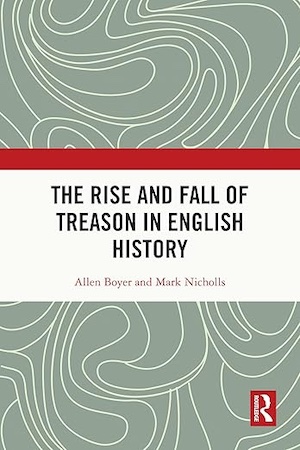By Fred H. Lawson
What exactly counts as treason has always been murky. It must entail more than just a refusal to comply with the wishes of the ruler, since some degree of opposition to authority is what comprises politics in every society. Closer to the mark would be to stipulate that treason consists of breaking one’s promise to support the ruler in times of peril, or worse yet choosing to align with an adversary against the ruler. Even these definitions smack of political expediency rather than matters of law, yet most governments reserve the severest punishment imaginable for engaging in treason.
Exploring the historical development of the notion of treason and the changing practices that have surrounded its adjudication consequently offers an enlightening glimpse into the basic mechanisms of governance. Thanks to the extensive records that have been preserved in various British archives, how things have developed in the case of the lands that became the United Kingdom can be traced from the time of King Aethelberht until now. But only with considerable effort, and by patiently compiling evidence from a broad range of primary and secondary sources.
Allen Boyer and Mark Nicholls accomplish this daunting exercise with aplomb. Starting with the seventh century of the Common Era, they recount telling episodes of treasonous behavior and the responses that such actions elicited from the authorities of the moment. What jumps out of the narrative of the early centuries of British history is the personalist nature of treason—traitors acted in ways that contravened their obligations to the ruler, not in ways that put the community at large in danger. Equally notable are the penalties imposed for treason: Most often they involved the forfeiture of property or the payment of heavy fines, not torture or execution. A turning point came in 1352, when the House of Commons adopted the Great Statute of Treasons in response to persistent domestic unrest while Edward III was undertaking military expeditions in France.
This law remains the basis for English jurisprudence with respect to treason today. It has of course been interpreted and applied in all sorts of ways across the centuries. During the era of the Tudors it acquired much of its current character, and in particular became intimately associated with the death penalty. More important, treason came to be linked to speech as well as to actions. Even hushed remarks in private could prove fatal. Later rulers sometimes took steps to rein in the expansion of the offense, but such vacillations left citizens unsure what would get them in serious trouble and what was permissible to say and do. Oddly enough, the American colonies’ Declaration of Independence did not count as treason, since it only “ascribed to George III a long series of tyrannical actions,” and “did not threaten the king’s life, adhere to his enemies, announce the levying of war against him, deny his title to the throne [or] disrupt his family life.”
By the close of the 18th century, the scope of treason started to become more compact. Protests that remained peaceful and took place in accordance with official regulations no longer counted as traitorous. Speech that impugned the ruler might now be considered seditious rather than treasonable. On the other hand, counterfeiting currency continued to be an instance of treason. In fact, “it was now forgers whose executions drew the crowds.”
Boyer and Nicholls argue that by the early 19th century prosecutions on the charge of treason had become obsolete. An 1832 law transformed counterfeiting into a felony, thereby removing the death penalty. Public revulsion against official executions grew so pronounced that charges of treason became “distasteful,” since any conviction brought a mandatory death sentence. Two individuals who actually shot at Queen Victoria were acquitted on grounds of mental defect. In 1848, Parliament created “a new offence, treason felony” in order to allow prosecutors to avoid such outcomes. Sir Roger Casement was hanged in 1916 for inciting anti-British sentiment in Ireland for the benefit of Germany, but “in death he became a martyr to his cause.” Those few persons who acted traitorously during the Second World War, who were almost all non-Britons, were charged according to a new Treachery Act that permitted the death penalty to be commuted by the court, and that was rescinded as soon as the war ended.
“While the 1352 Act endures,” the authors conclude, “much of what was once treason has fallen away over time.” Nevertheless, they observe, “a chill wind is blowing; authoritarianism and intolerance are on the rise, assuming many guises. . . . Under these conditions the old pulse starts to beat again. Treason twitches and bestirs itself.” Such words seem prescient at a moment when a major party candidate for the presidency of the United States openly kvetched that a former Chairman of the Joint Chiefs of Staff should be put on trial for treason.
Fred H. Lawson (ΦBK, Indiana University) is Adjunct Professor of International Relations at Universitas Brawijaya, Indonesia, and Professor of Government Emeritus of Northeastern University.




